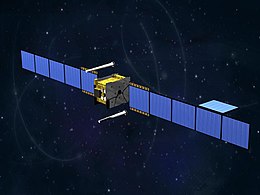 | |
| Mission type | Military communications |
|---|---|
| Operator | Paradigm Secure Communications EADS Astrium On behalf of British Ministry of Defence |
| COSPAR ID | 2007-056B |
| SATCAT no. | 32294 |
| Mission duration | 15 years |
| Spacecraft properties | |
| Bus | Eurostar 3000S |
| Manufacturer | Astrium |
| Launch mass | 4,635 kilograms (10,218 lb) |
| Start of mission | |
| Launch date | 14 November 2007, 22:06 (2007-11-14UTC22:06Z) UTC |
| Rocket | Ariane 5ECA V179 |
| Launch site | Kourou ELA-3 |
| Contractor | Arianespace |
| Orbital parameters | |
| Reference system | Geocentric |
| Regime | Geostationary |
| Longitude | 25° East |
Skynet 5B is a military communications satellite operated by Astrium Services, formerly Paradigm Secure Communications, on behalf of the British Ministry of Defence. It was the second of four Skynet 5 satellites to be launched.
Spacecraft
The Skynet 5B spacecraft is a Eurostar 3000S satellite, constructed by Astrium. At launch it had a mass of approximately 4,635 kilograms (10,218 lb), with a design life of 15 years. Its 34-metre (112 ft) solar arrays will generate a minimum of 6 kilowatts to power its UHF and X-band communications systems.
The Skynet 5 constellation was originally intended to consist of two satellites, the other of which, Skynet 5A, was launched earlier in 2007. By the time of Skynet 5B's launch, a decision had been made to launch the backup spacecraft, Skynet 5C, as an on-orbit spare; this was launched in 2008. Skynet 5D was ordered to replace the backup, however this too was launched in 2012. Skynet 5 replaced the earlier Skynet 4 system.
Launch
Skynet 5B was launched by an Ariane 5ECA carrier rocket flying from ELA-3 at Kourou. The launch occurred at 22:06 UTC on 14 November 2007. Star One C1 was launched aboard the same carrier rocket; Skynet 5B was mounted atop a Sylda 5 adaptor, with Star One C1 attached to the upper stage underneath the Sylda. Skynet 5B was the first of the two spacecraft to separate from the carrier rocket.
Orbit
The launch placed Skynet 5B into a 250 by 35,786 kilometres (155 by 22,236 mi) geosynchronous transfer orbit with 6 degrees of inclination. The satellite used its apogee motor to raise itself into geostationary orbit. It is located at a longitude of 53° East, in an orbit with a perigee of 35,572 kilometres (22,103 mi), an apogee of 35,867 kilometres (22,287 mi), and 0 degrees inclination.
References
- Krebs, Gunter. "Skynet 5A, 5B, 5C, 5D". Gunter's Space Page. Retrieved 28 January 2013.
- ^ "A dual launch for Brazil and the British MoD" (PDF). Arianespace. 9 November 2007. Archived from the original (PDF) on 29 October 2013. Retrieved 28 January 2013.
- "Skynet 5 Satellite Communications". British Army. Archived from the original on 20 September 2012. Retrieved 28 January 2013.
- Amos, Jonathan (14 November 2007). "UK military spacecraft launched". BBC News. Retrieved 28 January 2013.
- ^ Bergin, Chris (14 November 2007). "Ariane 5 ECA launches with Skynet 5B and Star One C1". NASASpaceflight.com. Retrieved 28 January 2013.
- Clark, Stephen (14 November 2007). "Ariane 5 launches British and Brazilian satellites". Spaceflight Now. Retrieved 28 January 2013.
- McDowell, Jonathan. "Satellite Catalog". Jonathan's Space Page. Retrieved 28 January 2013.
| Skynet satellites | |
|---|---|
| Skynet 1 | |
| Skynet 2 | |
| Skynet 4 | |
| Skynet 5 | |
| ← 2006Orbital launches in 20072008 → | |
|---|---|
| January | |
| February | |
| March | |
| April | |
| May | |
| June | |
| July | |
| August | |
| September | |
| October | |
| November | |
| December | |
| Launches are separated by dots ( • ), payloads by commas ( , ), multiple names for the same satellite by slashes ( / ). Crewed flights are underlined. Launch failures are marked with the † sign. Payloads deployed from other spacecraft are (enclosed in parentheses). | |